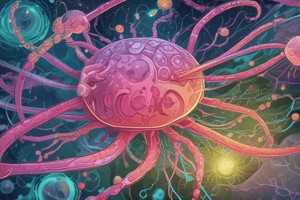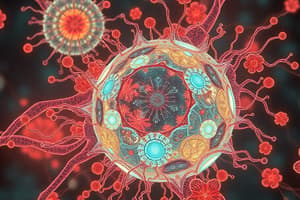Podcast
Questions and Answers
What is one of the primary benefits of combination chemotherapy?
What is one of the primary benefits of combination chemotherapy?
Which of the following is a major toxicity associated with cancer chemotherapy?
Which of the following is a major toxicity associated with cancer chemotherapy?
What is the primary aim of regional drug delivery methods in chemotherapy?
What is the primary aim of regional drug delivery methods in chemotherapy?
What is one possible outcome that should be considered when making the decision to treat cancer?
What is one possible outcome that should be considered when making the decision to treat cancer?
Signup and view all the answers
Which characteristic of cytotoxic anticancer drugs is true regarding their action on cells?
Which characteristic of cytotoxic anticancer drugs is true regarding their action on cells?
Signup and view all the answers
What is a primary manifestation of lung cancer?
What is a primary manifestation of lung cancer?
Signup and view all the answers
Which of the following is a characteristic of cachexia syndrome in cancer patients?
Which of the following is a characteristic of cachexia syndrome in cancer patients?
Signup and view all the answers
Which of the following is a common effect of tumor growth on adjacent structures?
Which of the following is a common effect of tumor growth on adjacent structures?
Signup and view all the answers
What syndrome may occur due to hormone-like proteins produced by cancer cells?
What syndrome may occur due to hormone-like proteins produced by cancer cells?
Signup and view all the answers
What is a systemic manifestation commonly experienced by cancer patients?
What is a systemic manifestation commonly experienced by cancer patients?
Signup and view all the answers
Which type of cancer is associated with the human papilloma virus (HPV)?
Which type of cancer is associated with the human papilloma virus (HPV)?
Signup and view all the answers
Which of the following best describes paraneoplastic syndromes?
Which of the following best describes paraneoplastic syndromes?
Signup and view all the answers
What is the effect of chemotherapy on blood counts in cancer patients?
What is the effect of chemotherapy on blood counts in cancer patients?
Signup and view all the answers
What is the mechanism of action for alkylating agents?
What is the mechanism of action for alkylating agents?
Signup and view all the answers
Which of the following best describes cell-cycle phase-specific drugs?
Which of the following best describes cell-cycle phase-specific drugs?
Signup and view all the answers
What is the primary dose-limiting toxicity associated with cyclophosphamide?
What is the primary dose-limiting toxicity associated with cyclophosphamide?
Signup and view all the answers
What are the toxicities of cytotoxic agents primarily seen in?
What are the toxicities of cytotoxic agents primarily seen in?
Signup and view all the answers
Which class of drugs is cyclophosphamide categorized under?
Which class of drugs is cyclophosphamide categorized under?
Signup and view all the answers
What is the primary use of hormonal agents in cancer treatment?
What is the primary use of hormonal agents in cancer treatment?
Signup and view all the answers
Which of the following is a primary treatment for breast cancer?
Which of the following is a primary treatment for breast cancer?
Signup and view all the answers
What is a significant adverse effect of the hormonal agent Tamoxifen?
What is a significant adverse effect of the hormonal agent Tamoxifen?
Signup and view all the answers
In which patient population is Tamoxifen primarily used?
In which patient population is Tamoxifen primarily used?
Signup and view all the answers
What is the mechanism of action of the monoclonal antibody Trastuzumab?
What is the mechanism of action of the monoclonal antibody Trastuzumab?
Signup and view all the answers
What characteristic of cancer cells allows them to spread to distant sites in the body?
What characteristic of cancer cells allows them to spread to distant sites in the body?
Signup and view all the answers
Which process marks the first step in the development of cancer?
Which process marks the first step in the development of cancer?
Signup and view all the answers
How do proto-oncogenes differ from tumor suppressor genes?
How do proto-oncogenes differ from tumor suppressor genes?
Signup and view all the answers
What does an increase in growth fraction in cancer cells indicate?
What does an increase in growth fraction in cancer cells indicate?
Signup and view all the answers
Which of the following factors is NOT associated with higher cancer mortality rates?
Which of the following factors is NOT associated with higher cancer mortality rates?
Signup and view all the answers
Which type of cancer is associated with mutations in the BRCA-1 gene?
Which type of cancer is associated with mutations in the BRCA-1 gene?
Signup and view all the answers
What is the role of immunotherapy in cancer treatment?
What is the role of immunotherapy in cancer treatment?
Signup and view all the answers
Which of the following statements about telomerase is true?
Which of the following statements about telomerase is true?
Signup and view all the answers
Study Notes
Faulty Cell Communication and Cancer Development
- Immortal cell lines have higher telomerase levels, leading to longer telomeres and resistance to aging.
- Cancer cells can invade, metastasize, and form secondary tumors after escaping from primary tumors.
Cancer Cell Cycle Dynamics
- Normally, cell production equals cell death, maintaining constant body cell numbers. In cancer, growth fraction increases while doubling time decreases.
- Tumors can be detected when they consist of approximately 1 billion cells.
- Oncogenesis is the process of healthy cells transforming into cancerous cells.
Cancer-Associated Genes
- Proto-oncogenes can mutate into oncogenes, leading to abnormal cell growth and cancer.
- Examples include the Philadelphia chromosome associated with chronic myelocytic leukemia and the HER-2/neu gene related to breast cancer.
- Tumor suppressor genes regulate cell division; mutations in these genes can remove cancer growth inhibition.
Stages of Carcinogenesis
- Initiation: DNA damage and mutations occur from carcinogenic agents.
- Promotion: Mutated cells are encouraged to divide.
- Progression: Tumor cells enhance aggressiveness through mutations leading to invasion and metastasis.
Environmental and Genetic Factors
- Inherited genes like BRCA-1 and BRCA-2 are linked to breast, ovarian, prostate, and pancreatic cancers.
- Reproductive hormones influence cancer risk in women (breast and ovarian) and men (prostate and testis).
- Obesity correlates with higher cancer mortality rates.
- Immunotherapy supports cancer resistance by utilizing immune system capabilities.
- Common carcinogens include tobacco, alcohol, high-fat/red meat diet, radiation, and oncogenic viruses like HPV and hepatitis B.
Clinical Manifestations of Cancer
- Symptoms depend on cancer type; lung cancer causes pulmonary dysfunction symptoms.
- Local effects include compression of adjacent structures, organ obstructions, and bleeding due to blood vessel invasion.
- Effusions can occur in pleural, pericardial, or peritoneal spaces, manifesting symptoms based on their location.
Systemic Manifestations
- Anorexia and cachexia syndrome lead to significant weight loss and protein wasting, especially in advanced cancer.
- Fatigue is common and often not alleviated by rest; sleep disturbances include poor quality and frequent awakenings.
- Anemia results from blood loss, inadequate red blood cell production, or nutritional deficiencies.
- Paraneoplastic syndromes involve hormone production by cancer cells affecting other body tissues, causing issues like Cushing syndrome.
Chemotherapy Strategies
- Intermittent chemotherapy allows normal cells to recover between treatments.
- Combination chemotherapy enhances efficacy by reducing drug resistance and maximizing cancer cell death while minimizing harm to normal cells.
- Regional drug delivery reduces systemic toxicity; methods include intra-arterial and intrathecal infusions.
Major Toxicities of Chemotherapy
- Common toxicities include bone marrow suppression (neutropenia, thrombocytopenia, anemia), digestive tract injury, alopecia, hyperuricemia, reproductive toxicity, and local injury from extravasation of vesicants.
Cytotoxic Agents and Their Mechanism
- Cytotoxic drugs target both cancer and healthy cells to induce cell death.
- Cell-cycle phase-specific drugs require continuous presence in the bloodstream and target specific phases of the cell cycle.
- Cell-cycle phase-nonspecific drugs can affect cancer cells at any stage.
Alkylating Agents
- These agents work by alkalizing DNA, and they are often associated with drug resistance.
- Examples include nitrogen mustards, specifically cyclophosphamide, which is a commonly used prodrug activated in the liver.
Hormonal Agents in Cancer Treatment
- Hormonal agents are primarily used for breast and prostate cancers, mimicking or blocking endogenous hormones' effects.
- Tamoxifen is significant for estrogen receptor-positive breast cancer, both for treatment and as preventative therapy in high-risk patients.
- Side effects of tamoxifen include hot flashes, fluid retention, nausea, and rare complications like thromboembolism.
Targeted Therapies
- Trastuzumab is a monoclonal antibody effective against HER2-overexpressing tumors, with mechanisms that inhibit growth and promote cell death.
- Cardiac toxicities and flu-like symptoms may manifest from trastuzumab infusions.
Studying That Suits You
Use AI to generate personalized quizzes and flashcards to suit your learning preferences.
Description
Explore the intricate relationship between faulty cell communication and cancer development. This quiz covers key concepts such as cell cycle dynamics, cancer-associated genes, and the mechanisms of oncogenesis. Test your understanding of how mutations can lead to abnormal cell growth and the implications for cancer progression.





